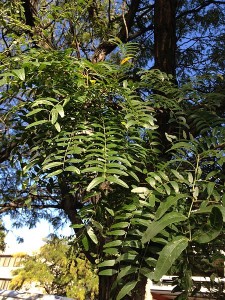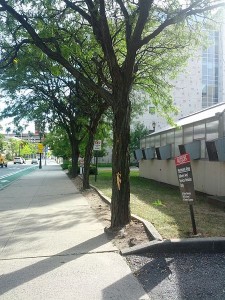Is the Honeylocust a good tree for my landscape?
A Honeylocust tree could be a sweet choice to add to your property’s landscape design. Of course no tree is perfect, but this variety is a widely used shade tree that can be found easily in our area, and we occasionally use them when one of our landscape designers determine it is a good choice for the site and meets the property owner’s needs. These medium-sized shade trees grow to approximately 30-50 ft. tall and 30-40 ft. wide.
PROS
- Fast-growing trees mean you can have shade sooner than later.
- Tolerant of extreme urban stresses which makes them great choices along parking areas.
- Small leaflets allow for filtered light underneath to grow turfgrass or partial shade plants.
- Small leaflets are easily mowed over in the fall in lawn areas, and easy to clean-up in landscapes.
- Strong wood that isn’t as prone to breaking as other tree varieties.
- Moderate considerations for regular pruning when compared to other varieties.
- Easily Crown-Raised to plant over decks, parking areas, and structures.
- The only major disease consideration we occasionally see is Canker. Keeping trees healthy can help to reduce chances for Canker.
- Bright yellow color in fall.
CONS
- The fruit pods, like large beans, can cause a mess for a short period of time in autumn.
- Some varieties may have thorns, but most cultivars we use do not.
- Insect issues such as Bagworm, Plant Bugs, Pod Gall Midge, Webworms, and Mites. However, these can be managed easily with finding a tree service to spray trees for insects as directed a few times throughout the year.
Conclusion

Overall, you can see the pros outweigh the cons for choosing a Honeylocust to include in your landscaping. If you can tolerate the little bit of mess they make for a short time in the fall, and also are prepared to have a tree service treat them with a Plant Health Care program when recommended, you will probably be very happy with choosing a Honeylocust. Be sure if you use a landscaper to plant trees like a Honeylocust on your property, to make sure they understand how far from structures, wires, etc. to install them. One of the common problems we see on properties when pruning trees or performing other services, is that sometimes a property owner or even a landscape contractor doesn’t allow enough room for this tree to grow. This can lead to improper tree trimming in the future as structures, wires, etc. need to be cleared from tree branches.
If you’d like to discuss planting trees or maintaining them on your property, please don’t hesitate to contact us.


